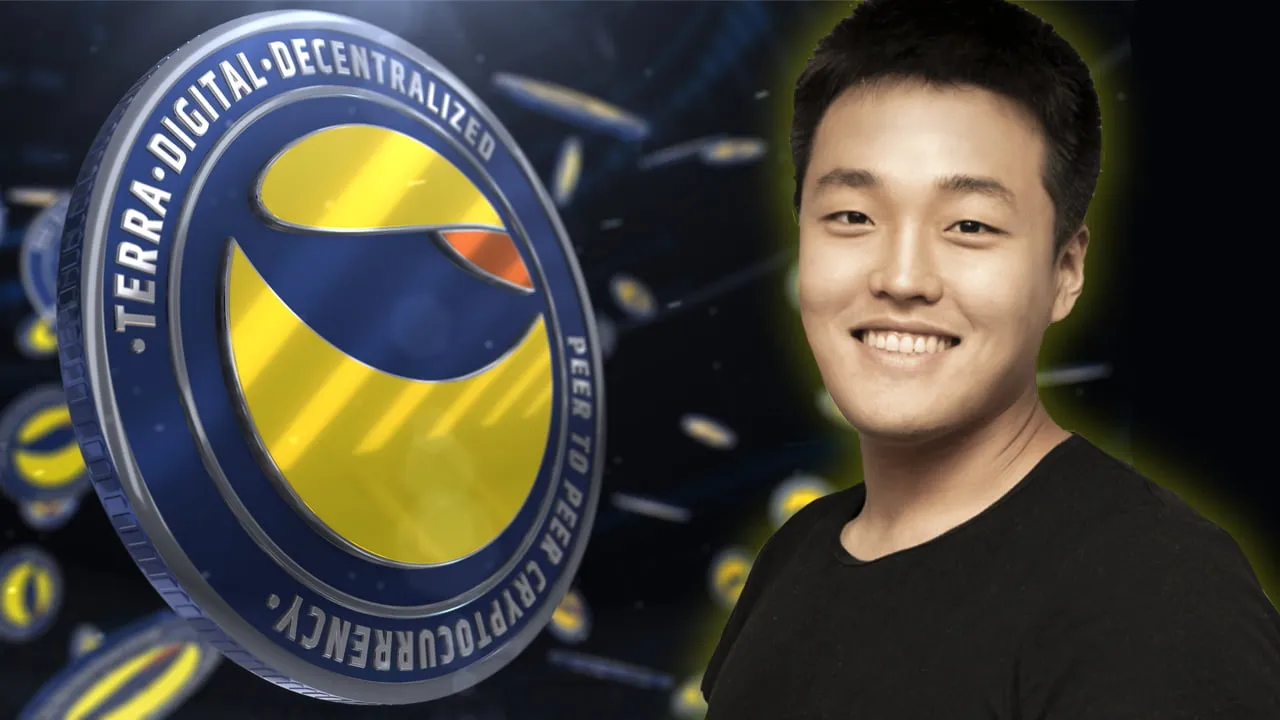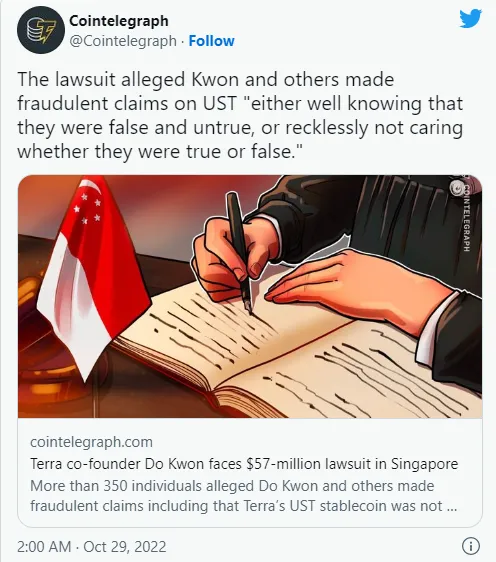Do Kwon, the co-founder of Terraform Labs who may be facing legal actions in South Korea and the United States, is the target of a lawsuit in Singapore along with the Luna Foundation Guard (LFG) and Terra founding member Nicholas Platias. In a lawsuit filed in Singapore’s high court on Sept. 23, 359 individuals allege Kwon, Platias, the LFG and Terra made fraudulent claims, including that Terra’s stablecoin, TerraUSD (UST) — now TerraUSD Classic (USTC) — was not 'stable by design' and unable to maintain its U.S. dollar peg. The claimants are seeking compensation for roughly $57 million worth of 'loss and damage' combined based on the value of UST tokens they purchased and held or sold amid the market downturn in May. They also request an order to pay for 'aggravated damages.'
[Wright. T. Terra co-founder Do Kwon faces $57-million lawsuit in Singapore. (Accessed October 29, 2022)].
"The suit features two lead claimants, Julian Moreno Beltran and Douglas Gan Yi Dong, who are nationals of Spain and Singapore respectively. These investors have alleged that Kwon fraudulently misrepresented the stability of TerraUSD on Terra’s white paper as well as its official website" [Anand, A. $57 Million Lawsuit Against Terra Co-Founder Do Kwon Comes To Light. (Accessed October 29, 2022)].
The 'Statement of Claim' filed with the Singapore High Court sets forth the key allegations of misrepresentation by Kwon, et. al. contained in Terra's White Paper and website. Specifically these allegations are:
In order to induce the Claimants to purchase UST tokens, the 1st to 3rd Defendants made the following representations:
a. First, that the UST tokens were stable by design, as they were pegged to a stable fiat currency (“1st Representation”).
b. Second, that the Terra protocol and its underlying token mechanics would be able to maintain the price stability of UST regardless of market size, volatility or demand through an algorithm that would allow an arbitrage process to happen with UST’s sister token, LUNA, guaranteeing that UST would always return to the 1 USD peg (“2nd Representation”).
c. Third, that UST holders would always be able to exchange 1 UST for 1 USD’s worth of LUNA on the Terra protocol (“3rd Representation”).
[Drew & Napier LLC. Beltran, et. ano. v. TERRAFORM LABS PTE LTD, et. al. Statement of Claim. (Accessed October 29, 2022)].
The Statement of Claim goes forward to make specific allegations concerning Anchor Protocol, to wit:
- In order to induce readers on the Internet, including several of the Claimants, to purchase UST tokens and to ‘stake’ (i.e., deposit) the UST tokens on Anchor, the 1st to 3rd Defendants made the following representations:
a. that Anchor was a principal-guaranteed stablecoin savings product where UST holders could enjoy the stability of holding a stablecoin while earning passive income (”4th Representation”)
b. that purchasers of UST would earn up to 20% Annualized Percentage Yield (“APY”) on Anchor if they staked their UST on the protocol (“5th Representation”).
[Id].
The LUNA FOUNDATION GUARD LTD. is likewise a named defendant [4th defendant] in this suit. The Plaintiff's allege:
b. Amongst other things, the 1st Defendant, for and on behalf of the 4th Defendant, promised to support and fund the Terra Ecosystem to 'buttress the stability of the UST peg';
c. To maintain the UST’s peg to the US Dollar, the 4th Defendant would build 'reserves that backstop the peg of algorithmic stablecoins amid volatility'.
- On 22 February 2022, the 4th Defendant announced that it had successfully raised USD 1 billion through the sale of LUNA tokens as a reserve fund to maintain the UST peg to the US Dollar by way of a PR release.
a. The 4th Defendant stated that the funding would be utilised toward building a bitcoin-denominated foreign-exchange reserve for UST.
b. Kanav Kariya stated, for and on behalf of the 4th Defendant, that the funding would be used to maintain the peg of the UST token
c. Crucially, the 3rd Defendant represented, for and on behalf of the 4th Defendant, that with the reserves built, the price peg and stability of the UST was assured: '[w]ith the UST Forex Reserve, the primary counter-argument for the sustainability of algorithmic stablecoins is eliminated' (the “6th Representation”)
[Id].
In light of the foregoing:
Induced by and acting in reliance upon each of the 1st to 6th Representations stated above, the Claimants believed that UST would be a token that was stable by design, whose price would always be pegged to the US Dollar, and which offered attractive APY returns for UST staked in Anchor. Additionally, the Claimants believed that the 4th Defendant would be able to maintain UST’s peg to the USD in any market situation due to its Bitcoin reserves.
Accordingly, the Claimants, listed in the annexed 3rd Schedule, purchased UST, thereby entering into an agreement with the 1st Defendant on terms set out below:
a. UST was stable by design, and pegged to the US Dollar;
b. the Terra protocol and its underlying token mechanics would be able to maintain UST’s price stability regardless of market size, volatility and/or demand through its algorithm;
c. that UST would always be able to exchange 1 UST for 1 USD’s worth of LUNA on the Terra protocol;
d. that Anchor was a principal-guaranteed stablecoin savings product where UST holders could enjoy the stability of holding a stablecoin while earning passive income;
e. that UST purchasers would earn up to 20% APY if they staked their UST on the protocol; and
f. that the 4th Defendant’s reserves would be able to protect the price stability of UST vis-à-vis the 1 USD peg
[Id].
Putting all of the above pieces together, the Plaintiff's claim the Defendant's fraudulently made each of the six representations, specifically alleging:
- Each of the Representations stated above were false in that:
a. In respect of the 1st Representation: UST was not “stable by design”, as it was not able to maintain its peg to the US Dollar.
b. In respect of the 2nd Representation: UST’s algorithm was not able to maintain the price stability of UST, as the peg was never able to recover.
c. In respect of the 3rd Representation: UST holders did not always maintain the ability to trade 1 UST for 1 USD’s worth of LUNA, given that the exchange function between UST and LUNA on the Terra protocol was turned off.
d. In respect of the 4th Representation: Anchor was not in fact 'principal guaranteed', given that the underlying value of UST collapsed.
e. In respect of the 5th Representation: Anchor was artificially subsidised by the 1st and 4th Defendants, and in fact had no actual way to keep up the 20% APY in the long run.
f. In respect of the 6th Representation: the 4th Defendant was not able to maintain the price peg of UST to the US Dollar as it had not in fact built up sufficient reserves, contrary to what the Defendants represented.
- The Defendants made the said representations fraudulently either well knowing that they were false and untrue, or recklessly not caring whether they were true or false.
[Id].
AUTHOR'S NOTE: The full contents of the Statement of Claim comprise 37 pages of allegations, details, particuliars and schedules. What has been presented herein is merely a short sampling of what appears to be the Plaintiff's main claim in the litigation and the key factors therein. The complete Statement of Claim may be accessed by clicking here.
That based on all of the Plaintiff's allegations, Plaintiff's are seeking the following relief:
AND the Claimants therefore claim: -
(1) Against the 1st to 4th Defendants a declaration under paragraphs 26 and 27 above that the Defendants are jointly and severally liable for the fraudulent misrepresentations
made;(2) A declaration that the unilateral contracts between the 1st Defendant and each individual Claimant be rescinded;
(3) The sum of US$56,948,675.49, being the sum equivalent to the diminution in value between the 1 USD peg for UST and the value of the UST being held by the Claimants and/or the price at which a Claimant sold below the 1 USD peg;
(4) Further, an order that the Defendants pay the Claimants aggravated damages, to be assessed;
(5) In the alternative to the above primary relief, if the Honourable Court does not grant the relief of rescission and the return of the sum of US$56,948,675.49, the Claimants
seek the following reliefs:a. an order that the Defendants pay the Claimants damages, including aggravated damages, for fraudulent misrepresentation, to be assessed;
b. alternatively, an order that the Defendants pay the Claimants damages for misrepresentation pursuant to section 2(1) of the Misrepresentation Act, to be assessed;
c. alternatively, an order that the Defendants pay the Claimants damages for negligent misstatement, in respect of the loss and damage referred to in paragraph 50 above, to be assessed;
d. Interest, pursuant to s 12 of the Civil Law Act;
e. Costs; and
f. Such further and other relief as this Honourable Court deems fit.
[Id].
This lawsuit has "[...] remained largely unnoticed until now. The lawsuit was filed on 23 September by Singapore based Drew & Napier [...]" [Anand, supra].
"South Korean authorities have been working to investigate the crypto crash in recent months. They issued an arrest warrant for the Terra co-founder in September, which was subsequently removed, and Interpol added Kwon to its Red Notice list, asking law enforcement to locate and have the possibility of detaining him. As for Do Kwon, he is still active on Twitter and always insists that he “doesn’t run away” and “has nothing to hide”. However, he kept his location a secret. According to Do Kwon’s fugitive investigation team, many have confirmed that he is hiding in Dubai due to the country’s crypto-friendly policy" [CoinCu News. Do Kwon Entangled In The $57 Million Lawsuit By Investors In Singapore. (Accessed October 29, 2022)]

